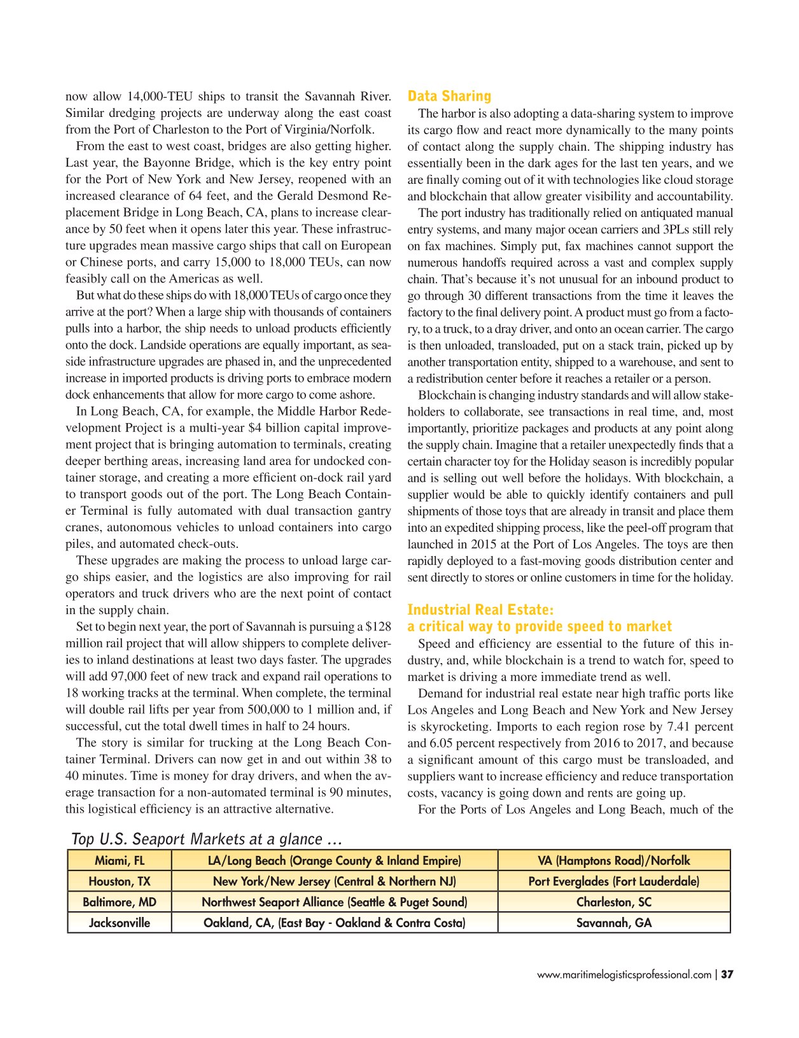
Page 37: of Maritime Logistics Professional Magazine (Mar/Apr 2018)
IT & Software
Read this page in Pdf, Flash or Html5 edition of Mar/Apr 2018 Maritime Logistics Professional Magazine
now allow 14,000-TEU ships to transit the Savannah River.
Data Sharing
Similar dredging projects are underway along the east coast The harbor is also adopting a data-sharing system to improve from the Port of Charleston to the Port of Virginia/Norfolk. its cargo fow and react more dynamically to the many points
From the east to west coast, bridges are also getting higher. of contact along the supply chain. The shipping industry has
Last year, the Bayonne Bridge, which is the key entry point essentially been in the dark ages for the last ten years, and we for the Port of New York and New Jersey, reopened with an are fnally coming out of it with technologies like cloud storage increased clearance of 64 feet, and the Gerald Desmond Re- and blockchain that allow greater visibility and accountability. placement Bridge in Long Beach, CA, plans to increase clear- The port industry has traditionally relied on antiquated manual ance by 50 feet when it opens later this year. These infrastruc- entry systems, and many major ocean carriers and 3PLs still rely ture upgrades mean massive cargo ships that call on European on fax machines. Simply put, fax machines cannot support the or Chinese ports, and carry 15,000 to 18,000 TEUs, can now numerous handoffs required across a vast and complex supply feasibly call on the Americas as well. chain. That’s because it’s not unusual for an inbound product to
But what do these ships do with 18,000 TEUs of cargo once they go through 30 different transactions from the time it leaves the arrive at the port? When a large ship with thousands of containers factory to the fnal delivery point. A product must go from a facto- pulls into a harbor, the ship needs to unload products effciently ry, to a truck, to a dray driver, and onto an ocean carrier. The cargo onto the dock. Landside operations are equally important, as sea- is then unloaded, transloaded, put on a stack train, picked up by side infrastructure upgrades are phased in, and the unprecedented another transportation entity, shipped to a warehouse, and sent to increase in imported products is driving ports to embrace modern a redistribution center before it reaches a retailer or a person. dock enhancements that allow for more cargo to come ashore. Blockchain is changing industry standards and will allow stake-
In Long Beach, CA, for example, the Middle Harbor Rede- holders to collaborate, see transactions in real time, and, most velopment Project is a multi-year $4 billion capital improve- importantly, prioritize packages and products at any point along ment project that is bringing automation to terminals, creating the supply chain. Imagine that a retailer unexpectedly fnds that a deeper berthing areas, increasing land area for undocked con- certain character toy for the Holiday season is incredibly popular tainer storage, and creating a more effcient on-dock rail yard and is selling out well before the holidays. With blockchain, a to transport goods out of the port. The Long Beach Contain- supplier would be able to quickly identify containers and pull er Terminal is fully automated with dual transaction gantry shipments of those toys that are already in transit and place them cranes, autonomous vehicles to unload containers into cargo into an expedited shipping process, like the peel-off program that piles, and automated check-outs. launched in 2015 at the Port of Los Angeles. The toys are then
These upgrades are making the process to unload large car- rapidly deployed to a fast-moving goods distribution center and go ships easier, and the logistics are also improving for rail sent directly to stores or online customers in time for the holiday. operators and truck drivers who are the next point of contact in the supply chain.
Industrial Real Estate:
Set to begin next year, the port of Savannah is pursuing a $128 a critical way to provide speed to market million rail project that will allow shippers to complete deliver- Speed and effciency are essential to the future of this in- ies to inland destinations at least two days faster. The upgrades dustry, and, while blockchain is a trend to watch for, speed to will add 97,000 feet of new track and expand rail operations to market is driving a more immediate trend as well.
18 working tracks at the terminal. When complete, the terminal Demand for industrial real estate near high traffc ports like will double rail lifts per year from 500,000 to 1 million and, if Los Angeles and Long Beach and New York and New Jersey successful, cut the total dwell times in half to 24 hours. is skyrocketing. Imports to each region rose by 7.41 percent
The story is similar for trucking at the Long Beach Con- and 6.05 percent respectively from 2016 to 2017, and because tainer Terminal. Drivers can now get in and out within 38 to a signifcant amount of this cargo must be transloaded, and 40 minutes. Time is money for dray drivers, and when the av- suppliers want to increase effciency and reduce transportation erage transaction for a non-automated terminal is 90 minutes, costs, vacancy is going down and rents are going up. this logistical effciency is an attractive alternative. For the Ports of Los Angeles and Long Beach, much of the
Top U.S. Seaport Markets at a glance …
Miami, FL LA/Long Beach (Orange County & Inland Empire) VA (Hamptons Road)/Norfolk
Houston, TX New York/New Jersey (Central & Northern NJ) Port Everglades (Fort Lauderdale)
Baltimore, MD Northwest Seaport Alliance (Seattle & Puget Sound) Charleston, SC
Jacksonville Oakland, CA, (East Bay - Oakland & Contra Costa) Savannah, GA www.maritimelogisticsprofessional.com 37
I

 36
36

 38
38
